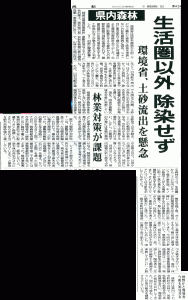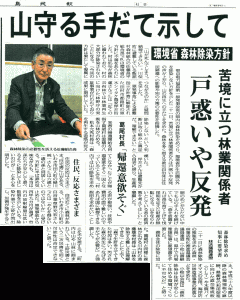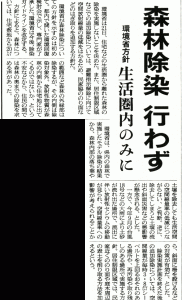Original Japanese written by staffer
The English below translated from the original Japanese by Heeday
The English translation edited by Rev. Dr. Henry French, ELCA
(Based on articles from the December 22nd, 2015 editions of the Fukushima Minpo and Asahi Shimbun newspapers)
▲Click each image and read the caption.
Concerning decontamination of forests in Fukushima Prefecture contaminated by the meltdown of TEPCO’s Fukushima Daiichi Nuclear Power Plant (NPP), Japan’s Ministry of the Environment has announced a new policy of not decontaminating any forest that is some 20m (22 yd.) or more from the nearest residence or farm. One reason for this decision was that no fallout of radioactive substances from such forests was detected that could affect the neighboring inhabited area. Yet another reason was that removal of fallen leaves in a forest could invite sediment runoff and other disasters.
Fukushima Prefecture is the third largest in area among all the 47 prefectures of Japan. Some 70% of the prefecture’s whole area is forest, which ranks No. 4 in forest area among the 47 – a vast amount of forest, indeed. Of the no-return areas in the prefecture, almost 80% is forest, whose total area extends to some 26,000 ha (64,220 acres). Ever since the forest was contaminated with radioactive fallout from the Fukushima Daiichi meltdown, no forestry work has been conducted there. Thus, the forest has been abandoned and is being ruined – a major social issue.
In response to the new policy announced by the Ministry, forestry organizations of Fukushima are raising their voices, calling for more thorough protective measures for logging workers to keep them safe from radiation exposure.
In November 2014, the Secretariat of the Nuclear Regulation Authority conducted a survey of air dose rates in the evacuated areas’ forests. The highest rate measured was 31 mSv per hour. An estimate made by the Fukushima Prefectural Government says the prefecture’s forests will have an average air dose rate of 2.6 mSv, a decade from now, with the maximum reaching 12 mSv, taking into consideration the natural decay of radioactive substances. For the evacuation directive to be lifted, the rate must come down to 3.8 mSv per hour or below. This estimate, therefore, implies that much of the prefecture’s contaminated forest will still be a no-go area ten years later. Those related to the Fukushima Federation of Forest Owners’ Co-operative Associations pointed out the necessity to “pay special attention to the mental health of those workers working in a contaminated forest.” Moreover, they said they were thinking of asking the national government and TEPCO to provide financial aid so that such workers can receive special allowances and/or higher hourly wages.
With respect to the many “shiitake” mushroom beds (raw wood on which the mushrooms grow) in Fukushima there are plans to resume the production of such wood. It is, therefore, an urgent task to reduce the radiation doses in bed wood forests. In many parts of these forests, such wood carries radioactive cesium above the threshold set by the Forestry Agency (50 becquerel per kg [2.2 lb.]) today. Fukushima used to enjoy the greatest shipment volume of such wood in the whole nation, yet its shipment volume in 2012 drastically dropped to only 6% of what it used to be before the meltdown. The Prefectural Government’s Forestry Promotion Section described its concerns, saying, “With no decontamination done, recovery of contaminated bed wood forests will slow down even more.”
Those municipalities affected by the meltdown, which contain vast forests and have many residents who are engaged in forestry, are worried that the Ministry’s decision will discourage evacuees from returning and will slow down such municipalities’ rebuilding.
We can easily imagine how hard it is, technically and financially, to decontaminate the vast forests of Fukushima. Still, I do believe the Ministry should spend more resources and time on research and development to find an effective and feasible solution. At the very least, we need to find a new solution, other than the current decontamination, to make the forest safer. It is impermissible to simply ignore these people who have been seriously affected by the meltdown.



